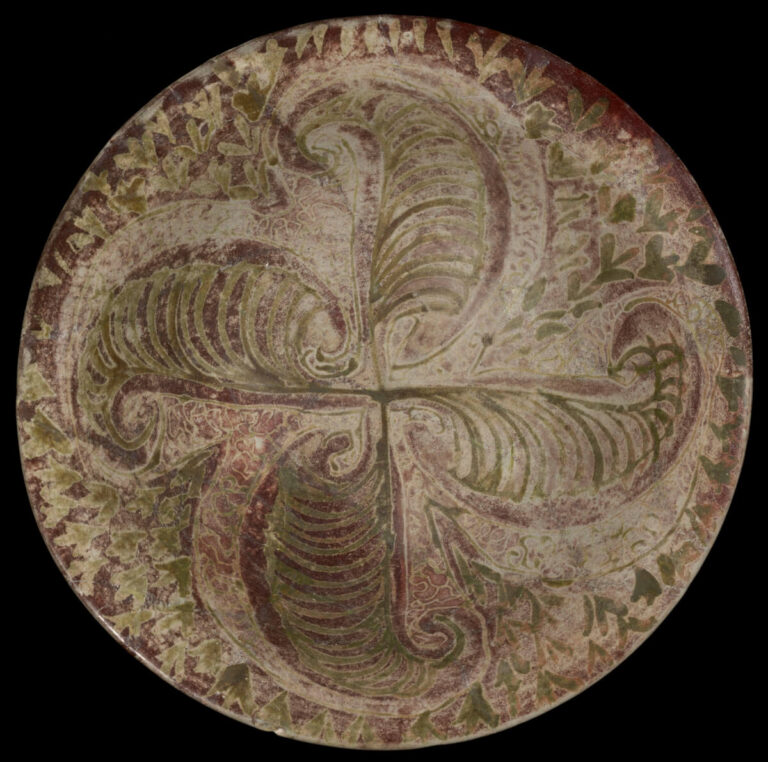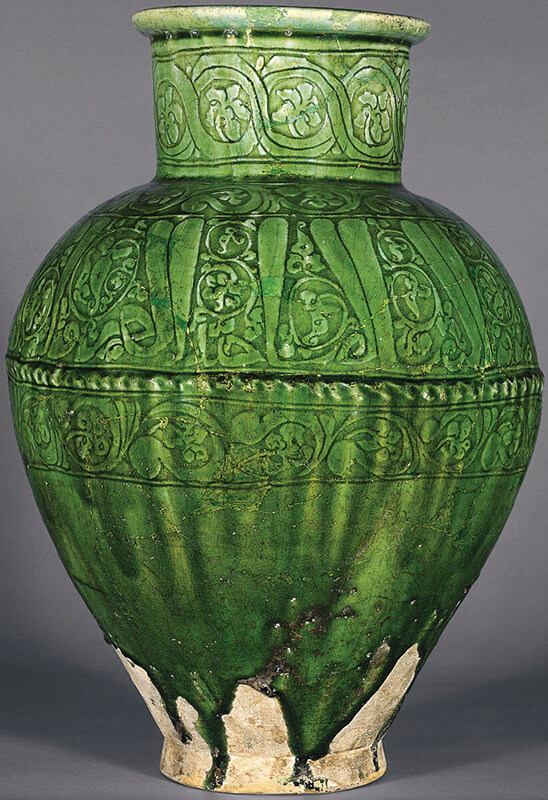
LNS 9 C
Earthenware bowl, metallic lustre-painted in copper red and olive green with whirling half-palmettes
Ceramics is one of the oldest industries, dating back to the Paleolithic era, more than 30,000 years ago. While The al-Sabah Collection is rich in ceramics, the primary focus of the collecting effort concentrated on covering the range of different techniques used by potters from the earliest Islamic period through to the 19th century. The examples below include an early earthenware bowl painted in lustre which displays a metallic sheen produced by metal oxides when the piece was fired a second time in a kiln low in oxygen. This technique of decoration was first employed on ceramics in Iraq in the 9th century CE, subsequently to spread far and wide over a period of almost a millennium.
The development of fritware in the 11th – 12th centuries CE provided the Islamic potter with a white body superficially simulating that of Chinese porcelain, which reigned supreme as the most luxurious and expensive of ceramics. Among well-known types of Islamic pottery with frit bodies are various large and small bowls, jars, etc., from Iranian lands, Syria and Turkey.
The use of polychrome ceramic tiles to decorate buildings was an ancient Near Eastern decorative tradition and became one of the most important products of the Islamic potter. Decorative techniques largely paralleled those employed for vessels. Additional techniques were developed for the manufacture of the large-scale designs that building tiles demanded.

Earthenware bowl, metallic lustre-painted in copper red and olive green with whirling half-palmettes

Composite bodied bowl painted in cobalt blue and metallic lustre, the inside center with birds amidst a quadripartite half-palmette scroll, against a dense spiralling scroll

Composite-bodied ceramic tile from the Mausoleum of Khwaja Rabi‘ at Mashhad (north-eastern Iran), the field with a centralized half-palmette arabesque which seamlessly weds the hexagonal

Reticulated double-walled composite-bodied ceramic ewer, the openwork shell decorated with seated princely figures enclosed in curvilinearized dodecagonal compartments

Composite-bodied ceramic ewer, the body covered with upright foliate scrolls bearing lotus blossoms, and the neck with a continuous scroll of leaves and lotus blossoms

Three-footed composite-bodied ceramic dish with lustre-painted enthroned and haloed prince seated amidst stemmed blossoms and foliage, suggesting a garden setting; underside of dish with paired

Three earthenware tiles, all featuring near-identical goats with tails terminating in curled half-palmettes

Unglazed earthenware tile (probably once part of a frieze) with the representation of a lion amidst a scroll, the lion’s tail and the scroll developing

Composite-bodied ceramic dish, the center with a configuration of six circular dense foliated and floriated scrolls and five stylized palmettes, bordered by eight paired Chinese-style

Two lustre tiles, probably from a shrine, inscribed with Qur’an chapter 55 (al-Rahman) vv.36-39 and chapter 34 (Saba`) vv.9-11
Kashan, Iran, second half 7th

Porcelain jar, probably produced for the domestic or foreign Islamic market, with a wide central band filled with an Islamic infinite pattern of ten-pointed stars,

Composite-bodied lustre-painted ceramic ‘tombstone’ with inscriptions in naskhi and nasta‘liq scripts, including a passage from the Qur’an (chapter 55, verses 26 and 27), an invocation

Mosaic inscriptional panel (composite bodied ceramic set into plaster), rendering part of verse 286, chapter 2 of the Qur’an, against a continuous spiralling scroll issuing

Composite bodied ceramic jar with a mannered cursive inscription around the shoulder, expressing good wishes to the owner

Earthenware bowl decorated in polychrome metallic lustre-painting in radial layout, with four shield-shaped compartments each containing a schematic plant and multiple lines of pseudo-Kufic script,

Composite-bodied ceramic dish featuring, at center an elephant fight before a royal pavilion, bordered by flowering plants in counterclockwise rotation

Composite-bodied ceramic dish, the well with a fanciful plant with serrated leaves and a central lotus leaf

Composite-bodied ceramic dish covered with whirling floral and foliate scrolls

Unglazed earthenware master-mould for the production of composite-bodied ceramic vessels, decorated with haloed figures wearing elaborate head-dresses, seated in arched ‘pavillions’; around the base, good